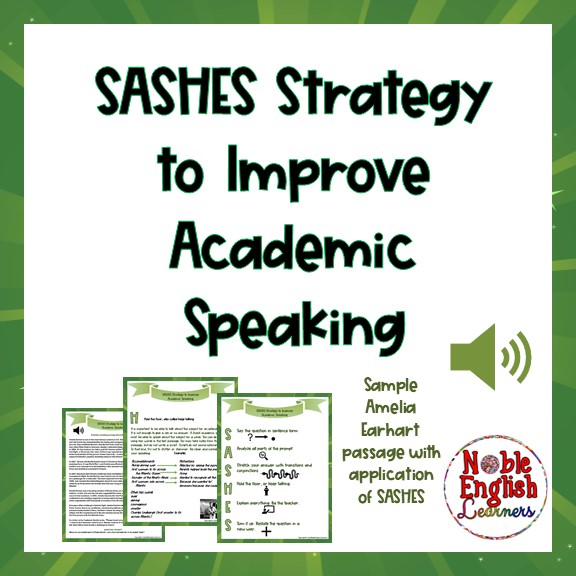Multilingual learners can use SASHES as a guideline to ensure they have a complete answer that “holds the floor”. Here is what the acronym SASHES stands for:
S= Say the question in sentence form
A= Analyze all parts of the prompt
S= Stretch your answer with transitions and conjunctions
H= Hold the floor, or keep talking
E= Explain everything. Be the teacher
S= Sum it up. Restate the question in a new way.
In my TpT store, Noble English Learners, I have created resources to go along with SASHES to help you teach your students each portion of the acronym.
These are all meant to go with ANY standardized speaking tests, not just WIDA.

SASHES Strategy For ESL ELL to Improve Academic Speaking
This product provides a poster with the acronym. The poster provides short memorable explanation for each step of the strategy, along with mnemonic icons. Additionally, a strategy is not useful unless a student can practice it. So, included in this product is a passage (with sound file) about Amelia Earhart, and a sample prompt/question. Each step of the strategy is then taken with the passage, so students can see exactly how it works. Finally, a sound file is included at the end with an answer to the Amelia Earhart question. This sound file is of a natural, fluent speaker. My daughter Isabel provides the model student answer. She makes me such a proud momma!
SASHES- Say the Question as a Statement (SQS)
Just as in writing, English learners should be encouraged to start the answer to a speaking prompt by restating the question as a statement. Therefore, I have made that be the first step in SASHES™ Strategy for Academic Speaking. The first ‘S’ represents “Say the Question as a Statement” or SQS. I have included 2 anchor charts, one helpful guide for making the statements, and 5 activities to practice. All of these activities should be reinforced with having your MLs practice recording their statements into microphone using websites like Flipgrid, Seesaw, Online Voice Recorder, or an app like Voice Memo (ios) or Voice Recorder (android). The matching activity and all anti-joke activities are fillable by students.
SASHES Strategy: Stretch Your Answer
The purpose of this is to stretch your speaking by including conjunctions and transitions. There are four activities included:
- Yes, and
- Somebody wanted but so
- Transition Words for Academic Speaking
- Superhero Conjunctions Boom Deck
All of these activities can be done online using synchronous software like Zoom, Google Meet, or on Teams, or can be assigned for independent practice.
SASHES Strategy Hold the Floor or Keep Talking
One of the most important thing for English students can do to make progress in academic speaking is to “hold the floor.” In other words, your MLs need to be able to speak about a topic for an extended amount of time. They have to keep talking. This is usually quite difficult. MLs can feel insecure about their accents or lack of advanced vocabulary. They need to gain confidence, so they need a lot of practice on “holding the floor.” In the file is a link to a Google Slides version that is interactive and a PowerPoint version of the same. This is perfect for distance learning!
Included in Hold the Floor Unit:
- Expanded Noun Phrases Explanation
- The Long and Winding Road
- Growing Your Own Noun Phrases
- Nested Noun Phrases in Cumulative Tales
- The House that Jack Built Readers’ Theater
- There Was an Old Lady that Swallowed a Fly Readers’ Theater
- Expanding Sentence
- Conversation Starters (broken out into individual slides on the included PowerPoint and Slides versions)
- Memory Circle
- Word Association games
- Word Chain
- Word Unchained Game
- 1 minute Experts
- Role Models
- Answer Keys

This game encourages them to use as many Talk Moves/Accountable Talk sentence stems and frames. After modeling the stems and frames with your Multilingual Learners, challenge your students to use as many as the stems and frames as they can during a week. As a student uses a stem/frame, they mark the spot on their BINGO board. When they get five across/down/diagonal, the student gets a prize. Students should get a new BINGO board for the next week.

Speaking Games and Activities for the ESL Classroom

Editable Speaking Practice Using Pictures and Illustrations
I hope this SASHES strategy for academic speaking helps you, but to help you further, I have written another post about helping your MLS with speaking. Also, I have been creating speaking practices to help my students get more opportunities to speak in this academic way, but I also want to teach them how. First, I created a narrated PowerPoint of Tips and Tricks for the Speaking portion of the WIDA.
Thank you all. If you have any questions, or comments, feel free to email me kim@nobleenglishlearners.com
Yours in learning,
Kim Noble Beiderman,
Noble English Learners




Leave a Reply